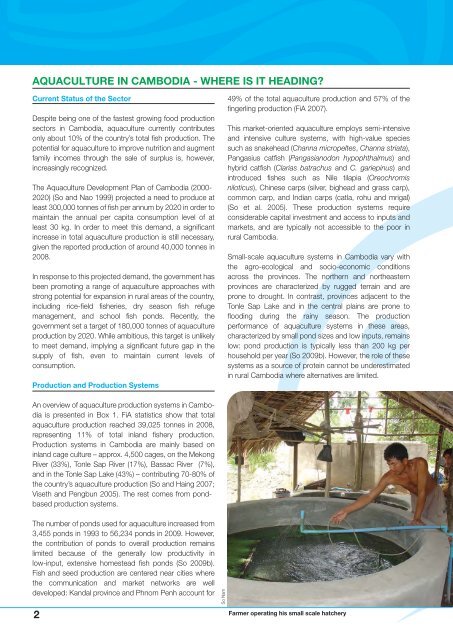Aquaculture for the Poor in Cambodia - World Fish Center
Aquaculture for the Poor in Cambodia - World Fish Center
Aquaculture for the Poor in Cambodia - World Fish Center
Create successful ePaper yourself
Turn your PDF publications into a flip-book with our unique Google optimized e-Paper software.
AQUACULTURE IN CAMBODIA - WHERE IS IT HEADING?<br />
Current Status of <strong>the</strong> Sector<br />
Despite be<strong>in</strong>g one of <strong>the</strong> fastest grow<strong>in</strong>g food production<br />
sectors <strong>in</strong> <strong>Cambodia</strong>, aquaculture currently contributes<br />
only about 10% of <strong>the</strong> country’s total fish production. The<br />
potential <strong>for</strong> aquaculture to improve nutrition and augment<br />
family <strong>in</strong>comes through <strong>the</strong> sale of surplus is, however,<br />
<strong>in</strong>creas<strong>in</strong>gly recognized.<br />
The <strong>Aquaculture</strong> Development Plan of <strong>Cambodia</strong> (2000-<br />
2020) (So and Nao 1999) projected a need to produce at<br />
least 300,000 tonnes of fish per annum by 2020 <strong>in</strong> order to<br />
ma<strong>in</strong>ta<strong>in</strong> <strong>the</strong> annual per capita consumption level of at<br />
least 30 kg. In order to meet this demand, a significant<br />
<strong>in</strong>crease <strong>in</strong> total aquaculture production is still necessary,<br />
given <strong>the</strong> reported production of around 40,000 tonnes <strong>in</strong><br />
2008.<br />
In response to this projected demand, <strong>the</strong> government has<br />
been promot<strong>in</strong>g a range of aquaculture approaches with<br />
strong potential <strong>for</strong> expansion <strong>in</strong> rural areas of <strong>the</strong> country,<br />
<strong>in</strong>clud<strong>in</strong>g rice-field fisheries, dry season fish refuge<br />
management, and school fish ponds. Recently, <strong>the</strong><br />
government set a target of 180,000 tonnes of aquaculture<br />
production by 2020. While ambitious, this target is unlikely<br />
to meet demand, imply<strong>in</strong>g a significant future gap <strong>in</strong> <strong>the</strong><br />
supply of fish, even to ma<strong>in</strong>ta<strong>in</strong> current levels of<br />
consumption.<br />
Production and Production Systems<br />
49% of <strong>the</strong> total aquaculture production and 57% of <strong>the</strong><br />
f<strong>in</strong>gerl<strong>in</strong>g production (FiA 2007).<br />
This market-oriented aquaculture employs semi-<strong>in</strong>tensive<br />
and <strong>in</strong>tensive culture systems, with high-value species<br />
such as snakehead (Channa micropeltes, Channa striata),<br />
Pangasius catfish (Pangasianodon hypophthalmus) and<br />
hybrid catfish (Clarias batrachus and C. gariep<strong>in</strong>us) and<br />
<strong>in</strong>troduced fishes such as Nile tilapia (Oreochromis<br />
niloticus), Ch<strong>in</strong>ese carps (silver, bighead and grass carp),<br />
common carp, and Indian carps (catla, rohu and mrigal)<br />
(So et al. 2005). These production systems require<br />
considerable capital <strong>in</strong>vestment and access to <strong>in</strong>puts and<br />
markets, and are typically not accessible to <strong>the</strong> poor <strong>in</strong><br />
rural <strong>Cambodia</strong>.<br />
Small-scale aquaculture systems <strong>in</strong> <strong>Cambodia</strong> vary with<br />
<strong>the</strong> agro-ecological and socio-economic conditions<br />
across <strong>the</strong> prov<strong>in</strong>ces. The nor<strong>the</strong>rn and nor<strong>the</strong>astern<br />
prov<strong>in</strong>ces are characterized by rugged terra<strong>in</strong> and are<br />
prone to drought. In contrast, prov<strong>in</strong>ces adjacent to <strong>the</strong><br />
Tonle Sap Lake and <strong>in</strong> <strong>the</strong> central pla<strong>in</strong>s are prone to<br />
flood<strong>in</strong>g dur<strong>in</strong>g <strong>the</strong> ra<strong>in</strong>y season. The production<br />
per<strong>for</strong>mance of aquaculture systems <strong>in</strong> <strong>the</strong>se areas,<br />
characterized by small pond sizes and low <strong>in</strong>puts, rema<strong>in</strong>s<br />
low: pond production is typically less than 200 kg per<br />
household per year (So 2009b). However, <strong>the</strong> role of <strong>the</strong>se<br />
systems as a source of prote<strong>in</strong> cannot be underestimated<br />
<strong>in</strong> rural <strong>Cambodia</strong> where alternatives are limited.<br />
An overview of aquaculture production systems <strong>in</strong> <strong>Cambodia</strong><br />
is presented <strong>in</strong> Box 1. FiA statistics show that total<br />
aquaculture production reached 39,025 tonnes <strong>in</strong> 2008,<br />
represent<strong>in</strong>g 11% of total <strong>in</strong>land fishery production.<br />
Production systems <strong>in</strong> <strong>Cambodia</strong> are ma<strong>in</strong>ly based on<br />
<strong>in</strong>land cage culture – approx. 4,500 cages, on <strong>the</strong> Mekong<br />
River (33%), Tonle Sap River (17%), Bassac River (7%),<br />
and <strong>in</strong> <strong>the</strong> Tonle Sap Lake (43%) – contribut<strong>in</strong>g 70-80% of<br />
<strong>the</strong> country’s aquaculture production (So and Ha<strong>in</strong>g 2007;<br />
Viseth and Pengbun 2005). The rest comes from pondbased<br />
production systems.<br />
The number of ponds used <strong>for</strong> aquaculture <strong>in</strong>creased from<br />
3,455 ponds <strong>in</strong> 1993 to 56,234 ponds <strong>in</strong> 2009. However,<br />
<strong>the</strong> contribution of ponds to overall production rema<strong>in</strong>s<br />
limited because of <strong>the</strong> generally low productivity <strong>in</strong><br />
low-<strong>in</strong>put, extensive homestead fish ponds (So 2009b).<br />
<strong>Fish</strong> and seed production are centered near cities where<br />
<strong>the</strong> communication and market networks are well<br />
developed: Kandal prov<strong>in</strong>ce and Phnom Penh account <strong>for</strong><br />
2<br />
So Nam<br />
Farmer operat<strong>in</strong>g his small scale hatchery
















